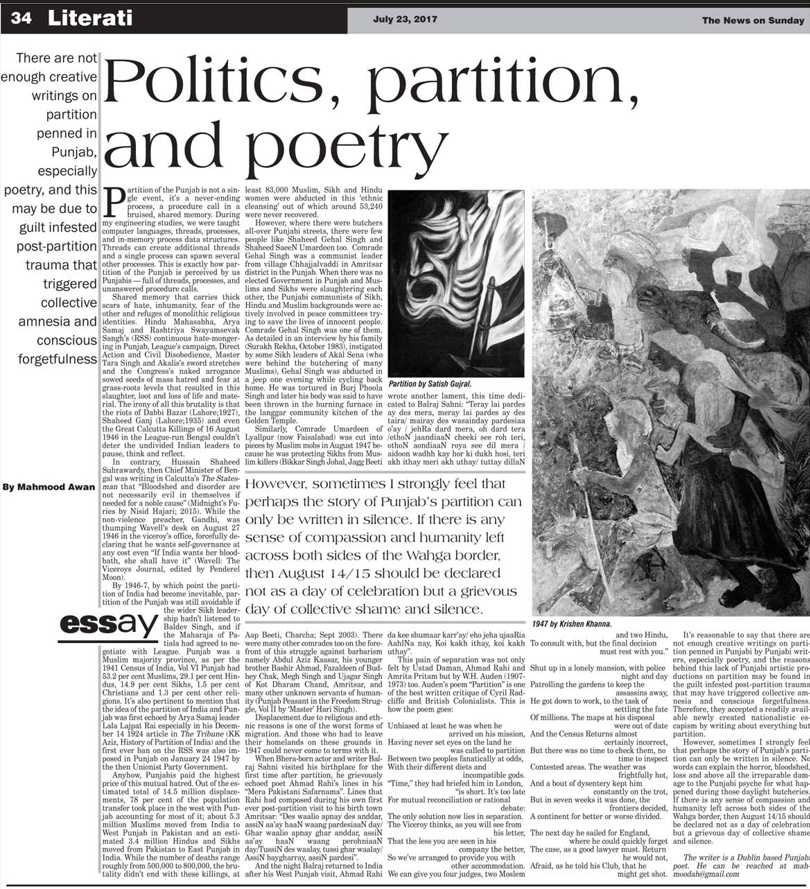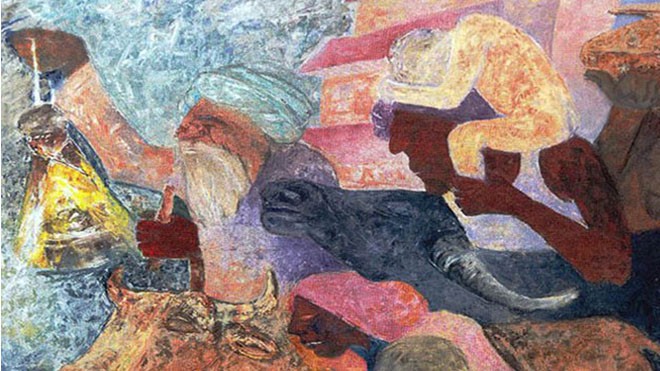Partition of the Punjab is not a single event, it’s a never-ending process, a procedure call in a bruised, shared memory. During my engineering studies, we were taught computer languages, threads, processes, and in-memory process data structures. Threads can create additional threads and a single process can spawn several other processes. This is exactly how partition of the Punjab is perceived by us Punjabis — full of threads, processes, and unanswered procedure calls.
Shared memory that carries thick scars of hate, inhumanity, fear of the other and refuges of monolithic religious identities. Hindu Mahasabha, Arya Samaj and Rashtriya Swayamsevak Sangh’s (RSS) continuous hate-mongering in Punjab, League’s campaign, Direct Action and Civil Disobedience, Master Tara Singh and Akalis’s sword stretches and the Congress’s naked arrogance sowed seeds of mass hatred and fear at grass-roots levels that resulted in this slaughter, loot and loss of life and material. The irony of all this brutality is that the riots of Dabbi Bazar (Lahore;1927), Shaheed Ganj (Lahore;1935) and even the Great Calcutta Killings of 16 August 1946 in the League-run Bengal couldn’t deter the undivided Indian leaders to pause, think and reflect.
In contrary, Hussain Shaheed Suhrawardy, then Chief Minister of Bengal was writing in Calcutta’s The Statesman that “Bloodshed and disorder are not necessarily evil in themselves if needed for a noble cause” (Midnight’s Furies by Nisid Hajari; 2015). While the non-violence preacher, Gandhi, was thumping Wavell’s desk on August 27 1946 in the viceroy’s office, forcefully declaring that he wants self-governance at any cost even “If India wants her bloodbath, she shall have it” (Wavell: The Viceroys Journal, edited by Penderel Moon).
By 1946-7, by which point the partition of India had become inevitable, partition of the Punjab was still avoidable if the wider Sikh leadership hadn’t listened to Baldev Singh, and if the Maharaja of Patiala had agreed to negotiate with League. Punjab was a Muslim majority province, as per the 1941 Census of India, Vol VI Punjab had 53.2 per cent Muslims, 29.1 per cent Hindus, 14.9 per cent Sikhs, 1.5 per cent Christians and 1.3 per cent other religions. It’s also pertinent to mention that the idea of the partition of India and Punjab was first echoed by Arya Samaj leader Lala Lajpat Rai especially in his December 14 1924 article in The Tribune (KK Aziz, History of Partition of India) and the first ever ban on the RSS was also imposed in Punjab on January 24 1947 by the then Unionist Party Government.
Anyhow, Punjabis paid the highest price of this mutual hatred. Out of the estimated total of 14.5 million displacements, 78 per cent of the population transfer took place in the west with Punjab accounting for most of it; about 5.3 million Muslims moved from India to West Punjab in Pakistan and an estimated 3.4 million Hindus and Sikhs moved from Pakistan to East Punjab in India. While the number of deaths range roughly from 500,000 to 800,000, the brutality didn’t end with these killings, at least 83,000 Muslim, Sikh and Hindu women were abducted in this ‘ethnic cleansing’ out of which around 53,240 were never recovered.
However, where there were butchers all-over Punjabi streets, there were few people like Shaheed Gehal Singh and Shaheed Saeen Umardeen too. Comrade Gehal Singh was a communist leader from village Chhajjalvaddi in Amritsar district in the Punjab. When there was no elected Government in Punjab and Muslims and Sikhs were slaughtering each other, the Punjabi communists of Sikh, Hindu and Muslim backgrounds were actively involved in peace committees trying to save the lives of innocent people. Comrade Gehal Singh was one of them. As detailed in an interview by his family (Surakh Rekha, October 1983), instigated by some Sikh leaders of Akãl Sena (who were behind the butchering of many Muslims), Gehal Singh was abducted in a jeep one evening while cycling back home. He was tortured in Burj Phoola Singh and later his body was said to have been thrown in the burning furnace in the langgar community kitchen of the Golden Temple.
Similarly, Comrade Umardeen of Lyallpur (now Faisalabad) was cut into pieces by Muslim mobs in August 1947 because he was protecting Sikhs from Muslim killers (Bikkar Singh Johal, Jagg Beeti Aap Beeti, Charcha; Sept 2003). There were many other comrades too on the forefront of this struggle against barbarism namely Abdul Aziz Kaasar, his younger brother Bashir Ahmad, Fazaldeen of Budhey Chak, Megh Singh and Ujagar Singh of Kot Dharam Chand, Amritsar, and many other unknown servants of humanity (Punjab Peasant in the Freedom Struggle, Vol II by ‘Master’ Hari Singh).
Displacement due to religious and ethnic reasons is one of the worst forms of migration. And those who had to leave their homelands on these grounds in 1947 could never come to terms with it.
When Bhera-born actor and writer Balraj Sahni visited his birthplace for the first time after partition, he grievously echoed poet Ahmad Rahi’s lines in his “Mera Pakistani Safarnama”. Lines that Rahi had composed during his own first ever post-partition visit to his birth town Amritsar:
“Des waalio apnay des anddar,
assiN aa’ay haaN waang pardesiaaN day
Ghar waalio apnay ghar anddar,
assiN aa’ay haaN waang perohniaaN day
TussiN des waalay, tussi ghar waalay
AssiN baygharray, assiN pardesi”.
And the night Balraj returned to India after his West Punjab visit, Ahmad Rahi wrote another lament, this time dedicated to Balraj Sahni:
Teray lai pardes ay des mera, meray lai pardes ay des taira
mairay des wasainday pardesiaa o’ay
jehRa dard mera, oh dard tera
ethoN jaandiaaN cheeki see roh teri
othoN aondiaaN roya see dil mera
aidoon wadhh kay hor ki dukh hosi
teri akh ithay meri akh uthay
tuttay dillaN da kee shumaar karr’ay
eho jeha ujaaRia AahlNa nay
Koi kakh ithay, koi kakh uthay”
This pain of separation was not only felt by Ustad Daman, Ahmad Rahi and Amrita Pritam but by W.H. Auden (1907-1973) too. Auden’s poem “Partition” is one of the best written critique of Cyril Radcliffe and British Colonialists. This is how the poem goes:
Unbiased at least he was when he arrived on his mission,
Having never set eyes on the land he was called to partition
Between two peoples fanatically at odds,
With their different diets and incompatible gods.
“Time,” they had briefed him in London, “is short. It’s too late
For mutual reconciliation or rational debate:
The only solution now lies in separation.
The Viceroy thinks, as you will see from his letter,
That the less you are seen in his company the better,
So we’ve arranged to provide you with other accommodation.
We can give you four judges, two Moslem and two Hindu,
To consult with, but the final decision must rest with you.”
Shut up in a lonely mansion, with police night and day
Patrolling the gardens to keep the assassins away,
He got down to work, to the task of settling the fate
Of millions. The maps at his disposal were out of date
And the Census Returns almost certainly incorrect,
But there was no time to check them, no time to inspect
Contested areas. The weather was frightfully hot,
And a bout of dysentery kept him constantly on the trot,
But in seven weeks it was done, the frontiers decided,
A continent for better or worse divided.
The next day he sailed for England, where he could quickly forget
The case, as a good lawyer must. Return he would not,
Afraid, as he told his Club, that he might get shot.
It’s reasonable to say that there are not enough creative writings on partition penned in Punjabi by Punjabi writers, especially poetry, and the reasons behind this lack of Punjabi artistic productions on partition may be found in the guilt infested post-partition trauma that may have triggered collective amnesia and conscious forgetfulness. Therefore, they accepted a readily available newly created nationalistic escapism by writing about everything but partition.
However, sometimes I strongly feel that perhaps the story of Punjab’s partition can only be written in silence. No words can explain the horror, bloodshed, loss and above all the irreparable damage to the Punjabi psyche for what happened during those daylight butcheries. If there is any sense of compassion and humanity left across both sides of the Wahga border, then August 14/15 should be declared not as a day of celebration but a grievous day of collective shame and silence.
Published on 23rd July 2017 in The News on Sunday.
https://www.thenews.com.pk/tns/detail/563686-politics-partition-poetry


